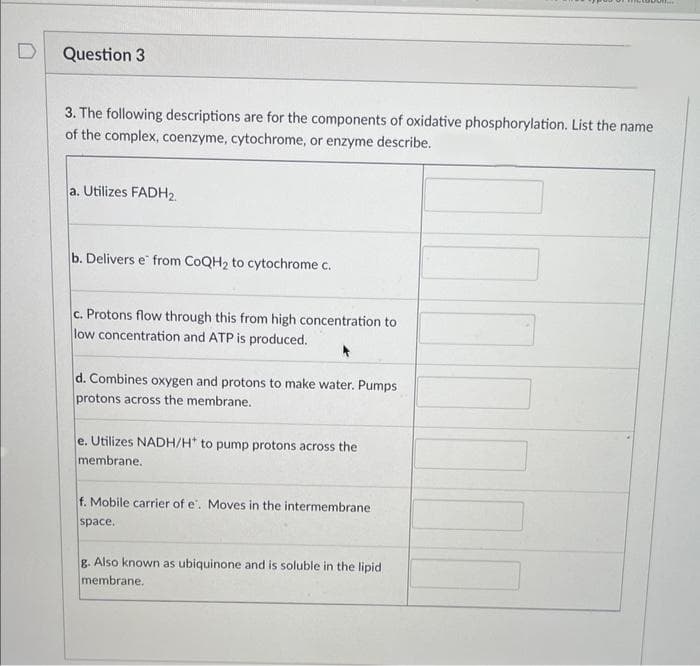3. The following descriptions are for the components of oxidative phosphorylation. List the name of the complex, coenzyme, cytochrome, or enzyme describe. a. Utilizes FADH₂. b. Delivers e from CoQH₂ to cytochrome c. c. Protons flow through this from high concentration to low concentration and ATP is produced. d. Combines oxygen and protons to make water. Pumps protons across the membrane. e. Utilizes NADH/H* to pump protons across the membrane. f. Mobile carrier of e. Moves in the intermembrane space. g. Also known as ubiquinone and is soluble in the lipid membrane. 111
3. The following descriptions are for the components of oxidative phosphorylation. List the name of the complex, coenzyme, cytochrome, or enzyme describe. a. Utilizes FADH₂. b. Delivers e from CoQH₂ to cytochrome c. c. Protons flow through this from high concentration to low concentration and ATP is produced. d. Combines oxygen and protons to make water. Pumps protons across the membrane. e. Utilizes NADH/H* to pump protons across the membrane. f. Mobile carrier of e. Moves in the intermembrane space. g. Also known as ubiquinone and is soluble in the lipid membrane. 111
Biology (MindTap Course List)
11th Edition
ISBN:9781337392938
Author:Eldra Solomon, Charles Martin, Diana W. Martin, Linda R. Berg
Publisher:Eldra Solomon, Charles Martin, Diana W. Martin, Linda R. Berg
Chapter8: How Cells Make Atp: Energy-releasing Pathways
Section: Chapter Questions
Problem 17TYU: EVOLUTION LINK The reactions of glycolysis are identical in all organismsprokaryotes, protists,...
Related questions
Topic Video
Question

Transcribed Image Text:D
Question 3
3. The following descriptions are for the components of oxidative phosphorylation. List the name
of the complex, coenzyme, cytochrome, or enzyme describe.
a. Utilizes FADH₂.
b. Delivers e from CoQH₂ to cytochrome c.
c. Protons flow through this from high concentration to
low concentration and ATP is produced.
d. Combines oxygen and protons to make water. Pumps
protons across the membrane.
e. Utilizes NADH/H* to pump protons across the
membrane.
f. Mobile carrier of e. Moves in the intermembrane
space.
wadrone
g. Also known as ubiquinone and is soluble in the lipid
membrane.
Expert Solution
This question has been solved!
Explore an expertly crafted, step-by-step solution for a thorough understanding of key concepts.
Step by step
Solved in 2 steps

Knowledge Booster
Learn more about
Need a deep-dive on the concept behind this application? Look no further. Learn more about this topic, biology and related others by exploring similar questions and additional content below.Recommended textbooks for you

Biology (MindTap Course List)
Biology
ISBN:
9781337392938
Author:
Eldra Solomon, Charles Martin, Diana W. Martin, Linda R. Berg
Publisher:
Cengage Learning

Anatomy & Physiology
Biology
ISBN:
9781938168130
Author:
Kelly A. Young, James A. Wise, Peter DeSaix, Dean H. Kruse, Brandon Poe, Eddie Johnson, Jody E. Johnson, Oksana Korol, J. Gordon Betts, Mark Womble
Publisher:
OpenStax College

Biology (MindTap Course List)
Biology
ISBN:
9781337392938
Author:
Eldra Solomon, Charles Martin, Diana W. Martin, Linda R. Berg
Publisher:
Cengage Learning

Anatomy & Physiology
Biology
ISBN:
9781938168130
Author:
Kelly A. Young, James A. Wise, Peter DeSaix, Dean H. Kruse, Brandon Poe, Eddie Johnson, Jody E. Johnson, Oksana Korol, J. Gordon Betts, Mark Womble
Publisher:
OpenStax College